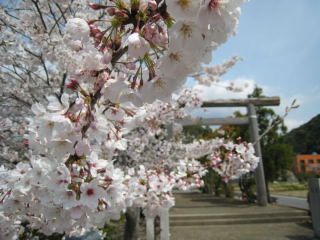
Torii
When visiting a Jinja(shrine), at first you pass under Torii.
Torii is the sacred symbol of the gate into Jinja. The origin and meaning of the word, Torii, haven't been elucidated perfectly yet, but, saying historically, a pair of wood poles standing at the gate of Jinja is said to be the origin of Torii.
Torii has various kinds of its type. (Refer to the following figure.)
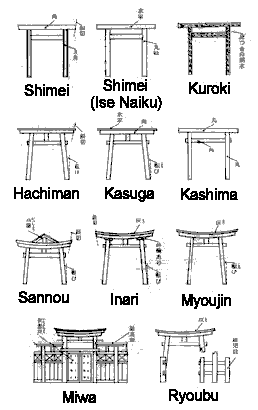
(Figure: Various kinds of Torii)
Amatsu Shinmei Jinja's Torii is the same type as Ise-Jingu's.
At Amatsu Shinmei Jinja, called "Boso Ise no Miya (the 2nd Ise-Jingu in Boso)", "Shikinen-Sengu", sacred ceremony of replacing an old palace with a new one, had been held once 20 years, as following Ise-Jingu, but in present, for some reasons, it is an old Torii with a new one that we hold the ceremony of replacing instead of palace.
And..., this event is "Shikinen-ToriiKi-Hiki-Sai", people calling, and we held it in 1995(Heisei 7) last. (Next is in 2015!)
Torii, you know, has lots of episodes.
Now, bow and refresh your mind, and let's go into Jinja!!
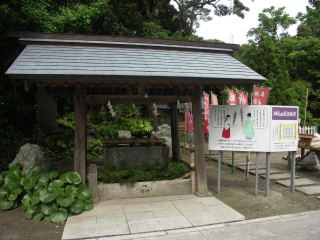
Temizu-sha
- cleaning hands with sacred water.
We have to wash our hands before worshiping at the sacred palace of Jinja(shrine). Japanese people call washing hands "Temizu", and a house where washing hands at Jinja is "Temizu-Sha" in Japanese.
Temizu, however, means not only washing your hands but also washing and refreshing your mind before going up to the front of Kami-Sama(gods). You, therefore, ought to do Temizu with your all hearts.
Now, introduce you how to do Temizu.
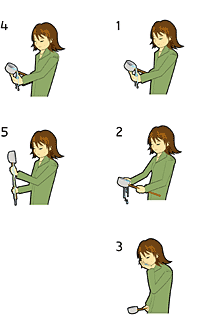
(Figure: the way of Temizu)
|
the way of Temizu
[1] Ladle some water with your right hand and wash your left palm.
[2] Shift the ladle from right hand to left and wash your right palm.
[3] Shift the ladle from left hand to right and store some water in your left palm, and rinse out your mouth with the water stored in left palm.
**ATTENTION!** Don't put your lip on the ladle.
[4] Wash your left palm by right hand.
[5] Put up the ladle to drain the water onto its handle.
|
After Temizu with refreshing your mind, let's go up on "Sandou", the approach to Jinja.
When going up on, you should not walking on "Seichu", the very middle of the approach, because Japanese think that "Seichu" is where Kami-Sama(gods) are walking.
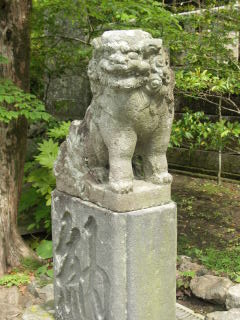
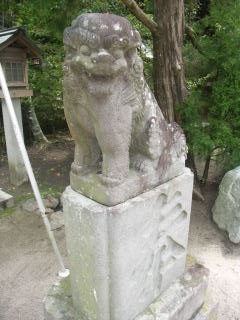
Komainu
In just front of the steps into
Jinja(shrine), at both sides of the approach, there are a pair of Komainu standing stongly.
Komainu is a sacred dog serving Kami-Sama(gods). The left Komainu and the right one are not the same.
Komainu is explained in "Dictionary of Shinto"(by Endo Sen) as such as the following.
- Komainu
- A pair of statues standing in the palace of Jinja or at Keidai(the precincts) in front of Jinja, for guard and ornamentation. It stands at temple as well as Jinja.
In "KinPiShou"(one of Japanese old books), "Shishi and Komainu stands at the northern and southern front of Tobari(a kind of Japanese walls), and left one is Shishi" it says.
Some of the old books explain that...
"Though Komainu has no horn and puts his ears up with his mouth closed, Shishi, a sacred lion, has a horn and puts his ears down with his mouth opened."
and, therefore, in old days Shishi and Komainu had been seperated, but later both of them got united into the word "Komainu".
The origin Komainu appeared at the ancient India, and it was introduced into Japan from China and Korea. For it came from Koma(=Korea), it got called "Koma-inu".("inu" means a dog.)
Komainu has many kinds of its own types.
- "Dictionary of Shinto" (Editted by Endo Sen)
Between the left Komainu and right one, you know, there are some differences.
Can you find the differences?
Watch the upper 2 photos, and you can find one of them which Komainu is opening his mouth or closing.
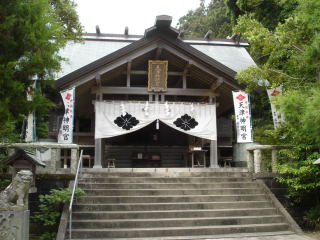
Shaden
- the main sacred palace
The main sacred palace of Amatsu Shinmei-goo stands at the deepest of the precinct.
The palace has some zones, and some of them are so sacred that even Shinto priests are not permitted to enter.
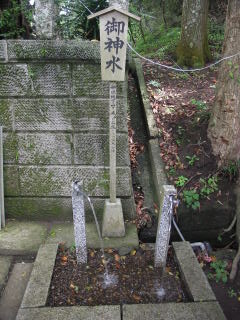
the sacred mineral water
Behind
Kasuga-sha, there is the place where you get the sacred mineral water.
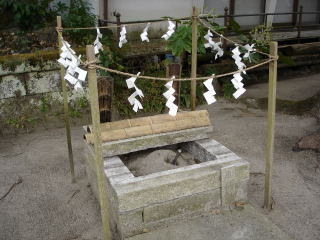
the sacred sand
In front of
Magoduri Dai-Myojin, there is the place where you get the sacred sand.
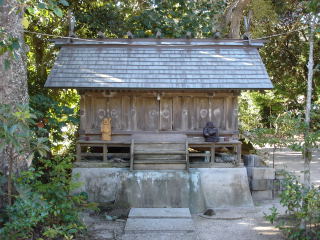
Nagagami-sha
Deified Kami-Sama(gods)
- Hachiman-Shin (Onin Tennou, HondaWake-no-Mikoto)
- Inari-Sama (Uga-no-Mitama-no-Kami)
- Yamagami-Sama ...etc.
At the westside of Keidai(the precincts), behind
Temizu-sha, there is Nagagami-sha with the small palace.
In Nagagami-sha there are many Kami-Sama deified, Hachiman-Shin, Inari-Sama, Yamagami-Sama and so on.
Hachiman-Shin, with Kasuga-Shin(Ame-no-Koyane-no-Mikoto), serves Shinmei-Sama(Amaterasu-Okami), and at the eastside of Keidai,therefore,
Kasuga-Shin is also deified.
Inari-Sama answers to a prayer with some commerce luck, so many merchants in this local-area have been worshipping him.
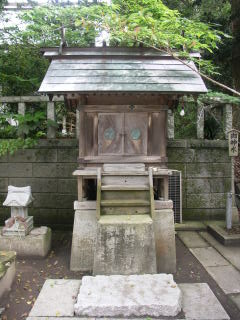
Kasuga-sha
Deified Kamisama(gods)
- Kasuga-Shin (Ame-no-Koyane-no-Mikoto)
- Sumiyoshi-SanShin
- SokoTsutsu-no-O-no-Mikoto
- NakaTsutsu-no-O-no-Mikoto
- UwaTsutsu-no-O-no-Mikoto
At the back eastside of Keidai(the precincts), there is Kasuga-sha with the small palace.
In Kasuga-sha there are Kasuga-Shin and Sumiyoshi-SanShin deified.
Kasuga-Shin, with Hachiman-Shin(Onin Tennou, HondaWake-no-Mikoto), serves Shinmei-Sama(Amaterasu-Okami), and Hachiman-Shin is also deified in
Nagagami-sha at the westside of Keidai, behind
Temizu-Sha.
At the other places near Amatsu Shinmei Jinja(shrine), there are also Hachiman Jinja and Kasuga Jinja, therefore it is said that their Jinja were built at the same time as Amatsu Shinmei Jinja founded.
Sumiyoshi-Sanshin had stood at the westside of Keidai before.
Shumiyoshi-Sanshin are believed to keep marine traffic safe from any accidents with Konpira-Sama, and lots of fishermen have worshipped them for a long time.
The roots of Sumiyoshi-Sanshin is said to be Sumiyoshi-Taisha(Osaka), and in the old era. it was looked up to as Kami-Sama(gods) who kept the Culture-Introduction Marine-Way from China and Korea safe, and then it expanded and expanded to all over Japan.
In this town there is a few Sumiyoshi Jinja.
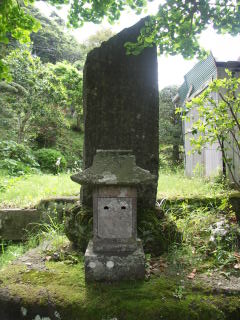
Magoduri Dai-Myojin
Deified Kamisama(gods)
- Magoduri Dai-Myojin
(Mr. SAITO Genroku)
At the eastside of Keidai (the precinct), Magoduri Dai-Myojin stands with a small palace of rocks.
Magoduri Dai-Myojin is Mr. SAITO Genroku who was a great fisherman in this town in Edo era.
He invented "Magoduri no Gyo-hou"; the method of fishing, and it gave a great benefit to the town, so people respect and deify him.
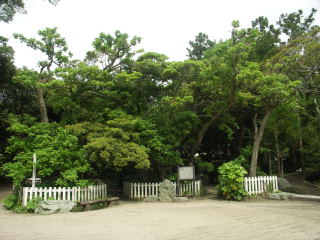
Marubachisha trees
- the nature monument specified by Chiba Pref.
"Marubachisha trees" standing at the westside of Keidai (the precincts) is a Nature Monument specified by Chiba Pref.
The largest one is 1.5 meters around.
"Marubachisha trees" is a kind of the subtropical trees, distributed in the south of China, Taiwan ...etc., Okinawa and Kyushu in Japan. Amatsu Shinmei Jinja is the most northern spot where "Marubachisha trees" can grow naturally, so "Marubachisha trees" standing here is much valuable.
In early summer you can see its small and white flowers, and in autumn its yellow nuts as small as about 1 centimeter. It is called an unusual tree because it is very hard to germinate its seeds.
It has the legend of "Nanja-Monja trees" (another name), therefore, "Marubachisha trees" is an interesting secred tree.
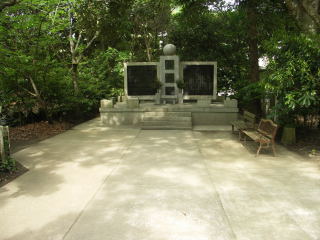
the cenotaph of the wars
At the back westside of Keidai (the precincts), there is the Cenotaph of Nichiro and Daitoua (the 2nd world war) wars.
At Nichiro and Daitoua wars, from this local-area lot's of young men were put into the front, but unfortunately some of them had never come back in alive. In order to console their souls and be grateful to them for their great work, people living in this area built this cenotaph.
In present the bereaved families and "Ireihi Hoson Kai" (Keeping Cenotaph Association) keep it clean.
On August. 15th in every year, the memorial service is held.
From the end of March to the begining of April, you can enjoy cherry blossoms at their best.
The cenotaph tells you the true value of peace.
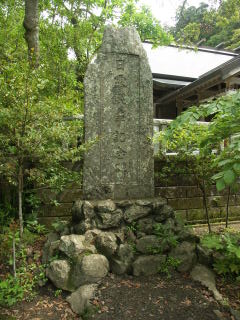
the monument of Nichiro war
At the westside of the steps into
Shaden (the Main Sacred Palace, there is the monument of Nichiro war standing.
This monument was built in celebration of the victory of Nichiro War, and it also means a great wish Japanese have had for a long and long time that the true peace over all the world realizes.
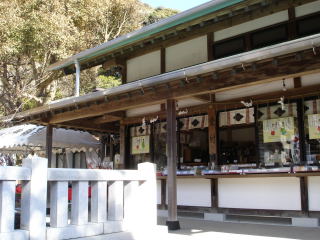
Information office
At the right side of the entrance of Keidai (the precinct), there is the Information office.
If you have any questions, contact us easily.
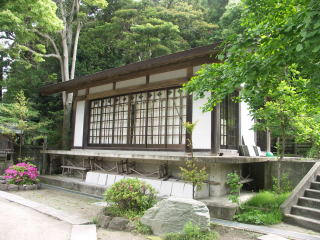
the stage
At the eastside of Keidai, "Butai", a stage in Japanese, stands.
On "Butai" various shows are held at several events.
At "Shinmei-goo Reisai", which is the biggest "Matsuri" event of Shinmei-goo in a year, some young girls living near play "Mai". "Mai" is one of Japanese traditional dances.
In "Butai" there is the 2nd shrine-house of
Naginami Jinja, which stands on the top of Naginami mountain behind Keidai.


















